Yixin Zhang
MCOP: Multi-UAV Collaborative Occupancy Prediction
Oct 14, 2025Abstract:Unmanned Aerial Vehicle (UAV) swarm systems necessitate efficient collaborative perception mechanisms for diverse operational scenarios. Current Bird's Eye View (BEV)-based approaches exhibit two main limitations: bounding-box representations fail to capture complete semantic and geometric information of the scene, and their performance significantly degrades when encountering undefined or occluded objects. To address these limitations, we propose a novel multi-UAV collaborative occupancy prediction framework. Our framework effectively preserves 3D spatial structures and semantics through integrating a Spatial-Aware Feature Encoder and Cross-Agent Feature Integration. To enhance efficiency, we further introduce Altitude-Aware Feature Reduction to compactly represent scene information, along with a Dual-Mask Perceptual Guidance mechanism to adaptively select features and reduce communication overhead. Due to the absence of suitable benchmark datasets, we extend three datasets for evaluation: two virtual datasets (Air-to-Pred-Occ and UAV3D-Occ) and one real-world dataset (GauUScene-Occ). Experiments results demonstrate that our method achieves state-of-the-art accuracy, significantly outperforming existing collaborative methods while reducing communication overhead to only a fraction of previous approaches.
DAG-AFL:Directed Acyclic Graph-based Asynchronous Federated Learning
Jul 28, 2025Abstract:Due to the distributed nature of federated learning (FL), the vulnerability of the global model and the need for coordination among many client devices pose significant challenges. As a promising decentralized, scalable and secure solution, blockchain-based FL methods have attracted widespread attention in recent years. However, traditional consensus mechanisms designed for Proof of Work (PoW) similar to blockchain incur substantial resource consumption and compromise the efficiency of FL, particularly when participating devices are wireless and resource-limited. To address asynchronous client participation and data heterogeneity in FL, while limiting the additional resource overhead introduced by blockchain, we propose the Directed Acyclic Graph-based Asynchronous Federated Learning (DAG-AFL) framework. We develop a tip selection algorithm that considers temporal freshness, node reachability and model accuracy, with a DAG-based trusted verification strategy. Extensive experiments on 3 benchmarking datasets against eight state-of-the-art approaches demonstrate that DAG-AFL significantly improves training efficiency and model accuracy by 22.7% and 6.5% on average, respectively.
LLM Agent for Hyper-Parameter Optimization
Jun 18, 2025Abstract:Hyper-parameters are essential and critical for the performance of communication algorithms. However, current hyper-parameters tuning methods for warm-start particles swarm optimization with cross and mutation (WS-PSO-CM) algortihm for radio map-enabled unmanned aerial vehicle (UAV) trajectory and communication are primarily heuristic-based, exhibiting low levels of automation and unsatisfactory performance. In this paper, we design an large language model (LLM) agent for automatic hyper-parameters-tuning, where an iterative framework and model context protocol (MCP) are applied. In particular, the LLM agent is first setup via a profile, which specifies the mission, background, and output format. Then, the LLM agent is driven by the prompt requirement, and iteratively invokes WS-PSO-CM algorithm for exploration. Finally, the LLM agent autonomously terminates the loop and returns a set of hyper-parameters. Our experiment results show that the minimal sum-rate achieved by hyper-parameters generated via our LLM agent is significantly higher than those by both human heuristics and random generation methods. This indicates that an LLM agent with PSO knowledge and WS-PSO-CM algorithm background is useful in finding high-performance hyper-parameters.
The Role of Machine Learning in Reducing Healthcare Costs: The Impact of Medication Adherence and Preventive Care on Hospitalization Expenses
Apr 10, 2025Abstract:This study reveals the important role of prevention care and medication adherence in reducing hospitalizations. By using a structured dataset of 1,171 patients, four machine learning models Logistic Regression, Gradient Boosting, Random Forest, and Artificial Neural Networks are applied to predict five-year hospitalization risk, with the Gradient Boosting model achieving the highest accuracy of 81.2%. The result demonstrated that patients with high medication adherence and consistent preventive care can reduce 38.3% and 37.7% in hospitalization risk. The finding also suggests that targeted preventive care can have positive Return on Investment (ROI), and therefore ML models can effectively direct personalized interventions and contribute to long-term medical savings.
LVC: A Lightweight Compression Framework for Enhancing VLMs in Long Video Understanding
Apr 09, 2025Abstract:Long video understanding is a complex task that requires both spatial detail and temporal awareness. While Vision-Language Models (VLMs) obtain frame-level understanding capabilities through multi-frame input, they suffer from information loss due to the sparse sampling strategy. In contrast, Video Large Language Models (Video-LLMs) capture temporal relationships within visual features but are limited by the scarcity of high-quality video-text datasets. To transfer long video understanding capabilities to VLMs with minimal data and computational cost, we propose Lightweight Video Compression (LVC), a novel method featuring the Query-Attention Video Compression mechanism, which effectively tackles the sparse sampling problem in VLMs. By training only the alignment layer with 10k short video-text pairs, LVC significantly enhances the temporal reasoning abilities of VLMs. Extensive experiments show that LVC provides consistent performance improvements across various models, including the InternVL2 series and Phi-3.5-Vision. Notably, the InternVL2-40B-LVC achieves scores of 68.2 and 65.9 on the long video understanding benchmarks MLVU and Video-MME, respectively, with relative improvements of 14.6% and 7.7%. The enhanced models and code will be publicly available soon.
Multipath Component-Aided Signal Processing for Integrated Sensing and Communication Systems
Dec 31, 2024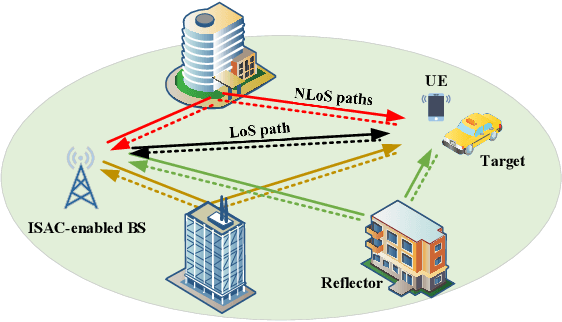
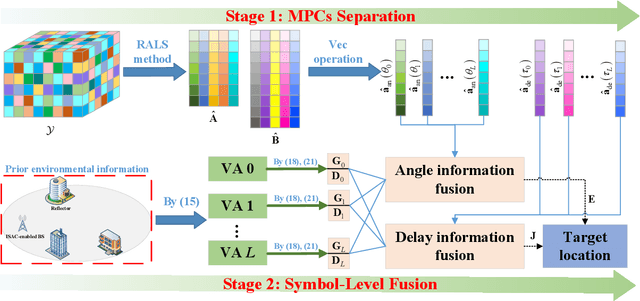

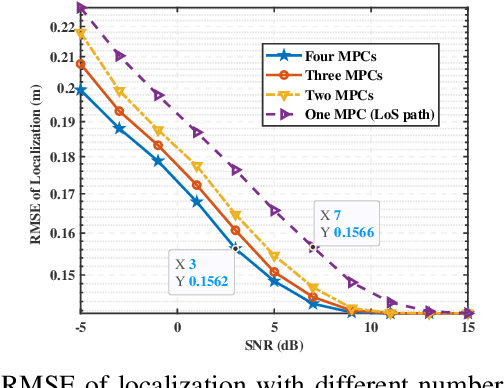
Abstract:Integrated sensing and communication (ISAC) has emerged as a pivotal enabling technology for sixth-generation (6G) mobile communication system. The ISAC research in dense urban areas has been plaguing by severe multipath interference, propelling the thorough research of ISAC multipath interference elimination. However, transforming the multipath component (MPC) from enemy into friend is a viable and mutually beneficial option. In this paper, we preliminarily explore the MPC-aided ISAC signal processing and apply a space-time code to improve the ISAC performance. Specifically, we propose a symbol-level fusion for MPC-aided localization (SFMC) scheme to achieve robust and high-accuracy localization, and apply a Khatri-Rao space-time (KRST) code to improve the communication and sensing performance in rich multipath environment. Simulation results demonstrate that the proposed SFMC scheme has more robust localization performance with higher accuracy, compared with the existing state-of-the-art schemes. The proposed SFMC would benefit highly reliable communication and sub-meter level localization in rich multipath scenarios.
How to select slices for annotation to train best-performing deep learning segmentation models for cross-sectional medical images?
Dec 11, 2024Abstract:Automated segmentation of medical images highly depends on the availability of accurate manual image annotations. Such annotations are very time-consuming and costly to generate, and often require specialized expertise, particularly for cross-sectional images which contain many slices for each patient. It is crucial to ensure the best use of annotation resources. In this paper, we systematically answer the question of how to select slices of cross-sectional medical images in order to maximize performance of the resulting deep learning segmentation models. We conducted experiments on 4 medical imaging segmentation tasks with varying annotation budgets, numbers of annotated cases, numbers of annotated slices per volume, slice selection techniques, and mask interpolations. We found that: 1) It is almost always preferable to annotate fewer slices per volume and more volumes given an annotation budget. 2) Selecting slices for annotation by unsupervised active learning (UAL) is not superior to selecting slices randomly or at fixed intervals, provided that each volume is allocated the same number of annotated slices. 3) Interpolating masks between annotated slices rarely enhances model performance, with exceptions of some specific configuration for 3D models.
Quantifying the Limits of Segment Anything Model: Analyzing Challenges in Segmenting Tree-Like and Low-Contrast Structures
Dec 05, 2024Abstract:Segment Anything Model (SAM) has shown impressive performance in interactive and zero-shot segmentation across diverse domains, suggesting that they have learned a general concept of "objects" from their large-scale training. However, we observed that SAM struggles with certain types of objects, particularly those featuring dense, tree-like structures and low textural contrast from their surroundings. These failure modes are critical for understanding its limitations in real-world use. In order to systematically examine this issue, we propose metrics to quantify two key object characteristics: tree-likeness and textural separability. Through extensive controlled synthetic experiments and testing on real datasets, we demonstrate that SAM's performance is noticeably correlated with these factors. We link these behaviors under the concept of "textural confusion", where SAM misinterprets local structure as global texture, leading to over-segmentation, or struggles to differentiate objects from similarly textured backgrounds. These findings offer the first quantitative framework to model SAM's challenges, providing valuable insights into its limitations and guiding future improvements for vision foundation models.
Advancing Sustainability via Recommender Systems: A Survey
Nov 12, 2024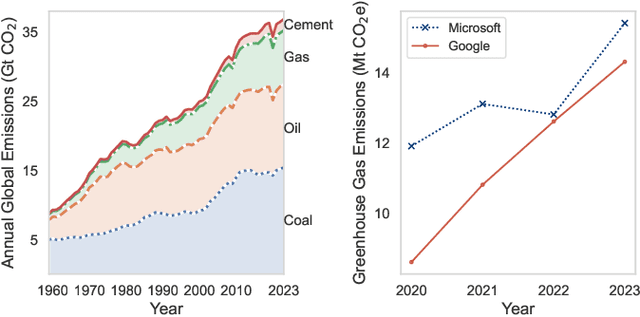
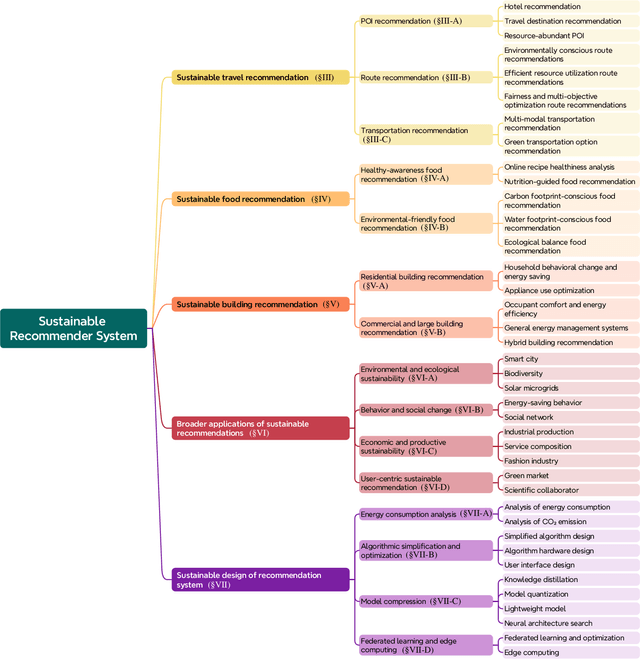
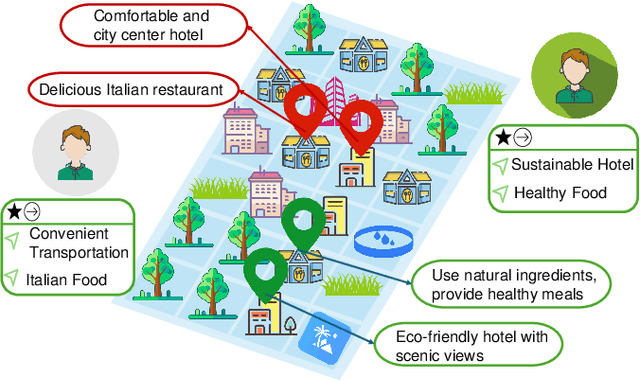
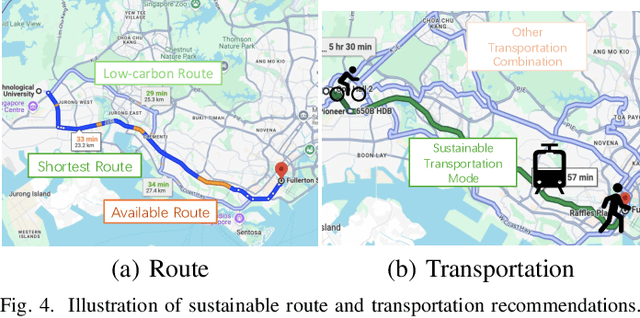
Abstract:Human behavioral patterns and consumption paradigms have emerged as pivotal determinants in environmental degradation and climate change, with quotidian decisions pertaining to transportation, energy utilization, and resource consumption collectively precipitating substantial ecological impacts. Recommender systems, which generate personalized suggestions based on user preferences and historical interaction data, exert considerable influence on individual behavioral trajectories. However, conventional recommender systems predominantly optimize for user engagement and economic metrics, inadvertently neglecting the environmental and societal ramifications of their recommendations, potentially catalyzing over-consumption and reinforcing unsustainable behavioral patterns. Given their instrumental role in shaping user decisions, there exists an imperative need for sustainable recommender systems that incorporate sustainability principles to foster eco-conscious and socially responsible choices. This comprehensive survey addresses this critical research gap by presenting a systematic analysis of sustainable recommender systems. As these systems can simultaneously advance multiple sustainability objectives--including resource conservation, sustainable consumer behavior, and social impact enhancement--examining their implementations across distinct application domains provides a more rigorous analytical framework. Through a methodological analysis of domain-specific implementations encompassing transportation, food, buildings, and auxiliary sectors, we can better elucidate how these systems holistically advance sustainability objectives while addressing sector-specific constraints and opportunities. Moreover, we delineate future research directions for evolving recommender systems beyond sustainability advocacy toward fostering environmental resilience and social consciousness in society.
OpenSatMap: A Fine-grained High-resolution Satellite Dataset for Large-scale Map Construction
Oct 30, 2024Abstract:In this paper, we propose OpenSatMap, a fine-grained, high-resolution satellite dataset for large-scale map construction. Map construction is one of the foundations of the transportation industry, such as navigation and autonomous driving. Extracting road structures from satellite images is an efficient way to construct large-scale maps. However, existing satellite datasets provide only coarse semantic-level labels with a relatively low resolution (up to level 19), impeding the advancement of this field. In contrast, the proposed OpenSatMap (1) has fine-grained instance-level annotations; (2) consists of high-resolution images (level 20); (3) is currently the largest one of its kind; (4) collects data with high diversity. Moreover, OpenSatMap covers and aligns with the popular nuScenes dataset and Argoverse 2 dataset to potentially advance autonomous driving technologies. By publishing and maintaining the dataset, we provide a high-quality benchmark for satellite-based map construction and downstream tasks like autonomous driving.
 Add to Chrome
Add to Chrome Add to Firefox
Add to Firefox Add to Edge
Add to Edge